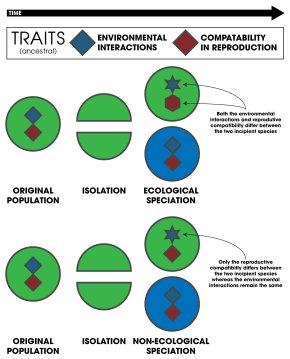 Global Information
Global InformationNonecological speciation information

When speciation is not driven by (or strongly correlated with) divergent natural selection, it can be said to be nonecological,[1][2] so as to distinguish it from the typical definition of ecological speciation: "It is useful to consider ecological speciation as its own form of species formation because it focuses on an explicit mechanism of speciation: namely divergent natural selection. There are numerous ways other than via divergent natural selection in which populations might become genetically differentiated and reproductively isolated."[3] It is likely that many instances of nonecological speciation are allopatric, especially when the organisms in question are poor dispersers (e.g., land snails, salamanders), however sympatric nonecological speciation may also be possible, especially when accompanied by an "instant" (at least in evolutionary time) loss of reproductive compatibility, as when polyploidization happens.[2][4] Other potential mechanisms for nonecological speciation include mutation-order speciation[5] and changes in chirality in gastropods.[6]
Nonecological speciation might not be accompanied by strong morphological differentiation, so might give rise to cryptic species, however there are some species that are difficult for humans to differentiate that are strongly differentiated with respect to their resource use, and so are likely a result of ecological speciation (e.g., host shifts in parasites or phytophagous insects).[7][8] When species recognition/sexual selection plays a strong role in maintaining species boundaries, the species generated by nonecological speciation might be straightforward for humans to differentiate, as in some odonates.[9]
- ^ Rundell, Rebecca J.; Price, Trevor D. (2009-07-01). "Adaptive radiation, nonadaptive radiation, ecological speciation and nonecological speciation". Trends in Ecology & Evolution. 24 (7): 394–399. doi:10.1016/j.tree.2009.02.007. ISSN 0169-5347. PMID 19409647.
- ^ a b Czekanski-Moir, Jesse E.; Rundell, Rebecca J. (2019-05-01). "The Ecology of Nonecological Speciation and Nonadaptive Radiations" (PDF). Trends in Ecology & Evolution. 34 (5): 400–415. doi:10.1016/j.tree.2019.01.012. ISSN 0169-5347. PMID 30824193. S2CID 73494468.
- ^ Nosil, Patrik. (2012). Ecological speciation. Oxford: Oxford University Press. ISBN 978-0-19-162801-6. OCLC 787851773.
- ^ Les, Donald H.; Peredo, Elena L.; King, Ursula M.; Benoit, Lori K.; Tippery, Nicholas P.; Ball, Cassandra J.; Shannon, Robynn K. (2015-01-01). "Through thick and thin: Cryptic sympatric speciation in the submersed genus Najas (Hydrocharitaceae)". Molecular Phylogenetics and Evolution. 82: 15–30. doi:10.1016/j.ympev.2014.09.022. ISSN 1055-7903. PMID 25300454.
- ^ Nosil, Patrik; Flaxman, Samuel M. (2011-02-07). "Conditions for mutation-order speciation". Proceedings of the Royal Society B: Biological Sciences. 278 (1704): 399–407. doi:10.1098/rspb.2010.1215. PMC 3013408. PMID 20702458.
- ^ Gittenberger, Edmund; Hamann, Thomas D.; Asami, Takahiro (2012-04-20). "Chiral Speciation in Terrestrial Pulmonate Snails". PLOS ONE. 7 (4): e34005. Bibcode:2012PLoSO...734005G. doi:10.1371/journal.pone.0034005. ISSN 1932-6203. PMC 3332057. PMID 22532825.
- ^ Faucci, Anuschka; Toonen, Robert J; Hadfield, Michael G (2007-01-07). "Host shift and speciation in a coral-feeding nudibranch". Proceedings of the Royal Society B: Biological Sciences. 274 (1606): 111–119. doi:10.1098/rspb.2006.3685. PMC 1679885. PMID 17134995.
- ^ Lee, Y.; Lee, W.; Lee, S.; Kim, H. (February 2015). "A cryptic species of Aphis gossypii (Hemiptera: Aphididae) complex revealed by genetic divergence and different host plant association". Bulletin of Entomological Research. 105 (1): 40–51. doi:10.1017/S0007485314000704. ISSN 0007-4853. PMID 25413997. S2CID 26358620.
- ^ Wellenreuther, Maren; Sánchez-Guillén, Rosa Ana (2016). "Nonadaptive radiation in damselflies". Evolutionary Applications. 9 (1): 103–118. Bibcode:2016EvApp...9..103W. doi:10.1111/eva.12269. ISSN 1752-4571. PMC 4780385. PMID 27087842.